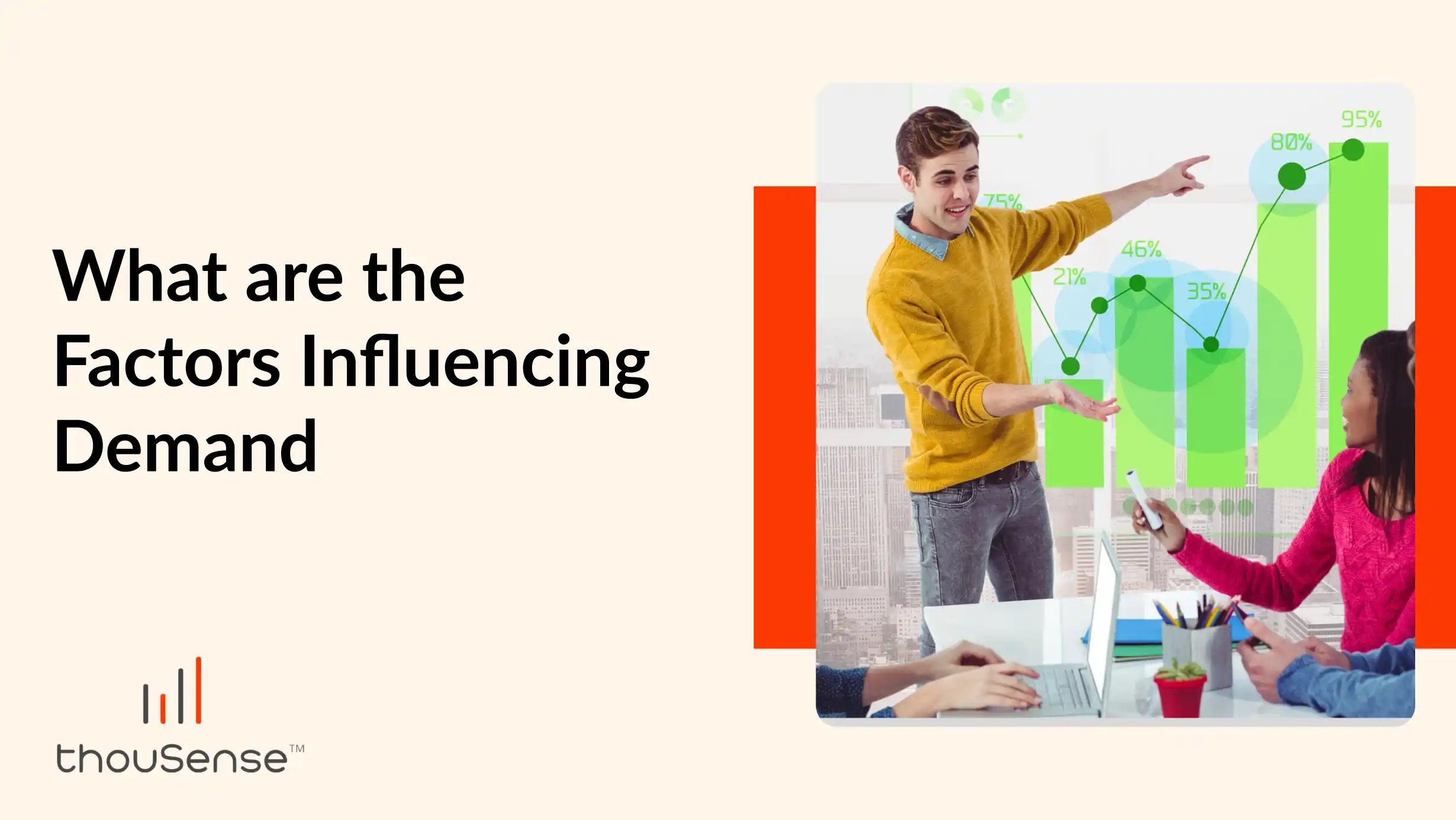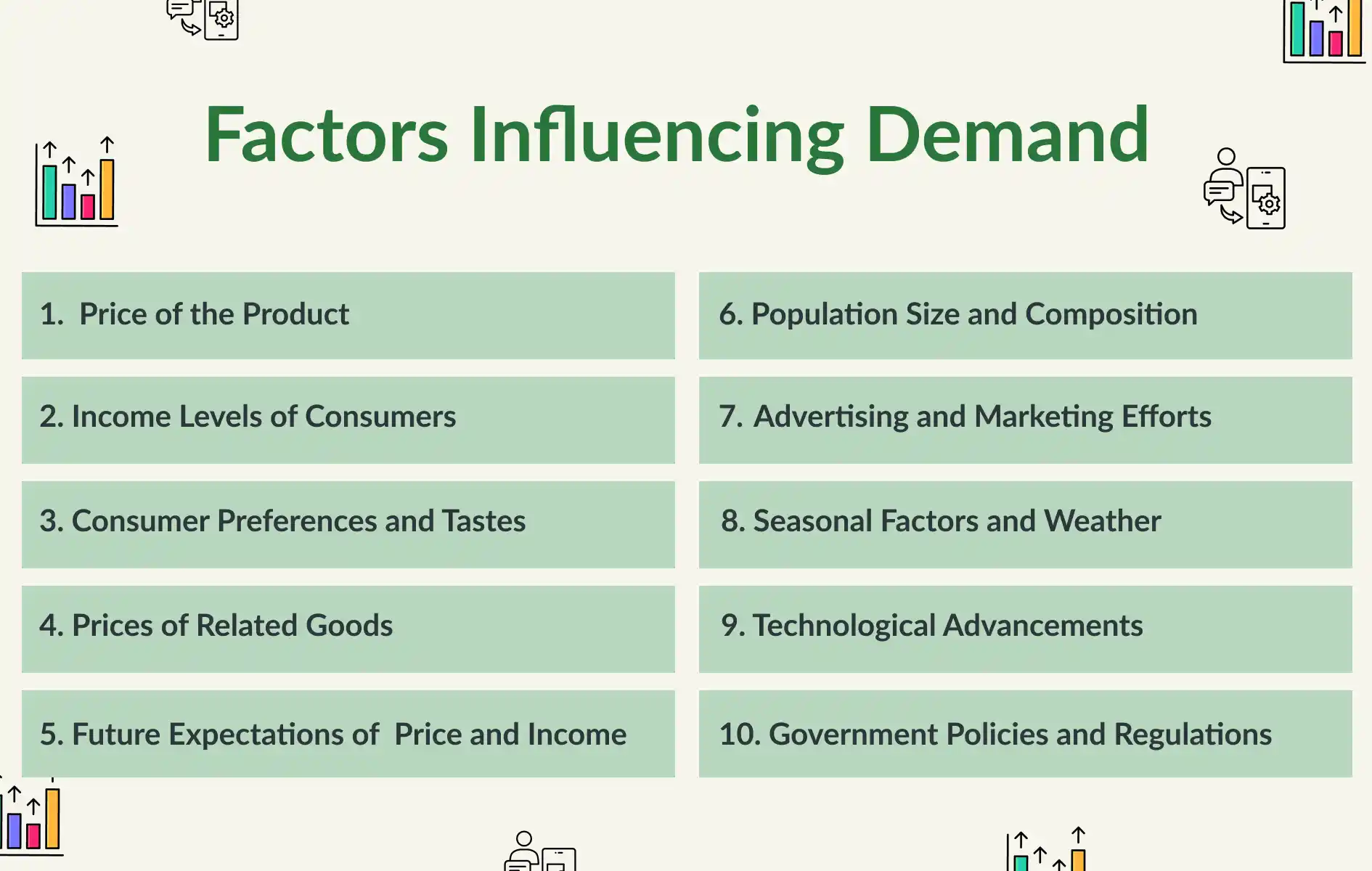What are the Factors Influencing Demand | thouSense

Demand is a key concept in economics that refers to how much of a good or service people want and are willing to buy at a certain price. Understanding the factors influencing demand is essential for businesses and governments. It helps predict future trends, also known as demand forecasting, and make smart decisions. This blog will explore the various factors that affect demand clearly and simply.
Let's understand the factors influencing demand from the following points:-
10 Factors Influencing Demand

1. Price of the Product
The price of a product plays a significant role in influencing demand. When prices increase, consumer demand for a product typically declines. This is because individuals may either be unwilling to spend more or may find the higher cost unaffordable. For instance, if the price of chocolate were to double, fewer consumers would likely make a purchase. Conversely, when prices decrease, demand often rises, as consumers perceive greater value and are more inclined to take advantage of the lower cost.
This relationship between price and demand is important for demand forecasting. If businesses know that a lower price leads to higher demand, they can plan accordingly. However, the change in demand due to price also depends on how important the product is to people. Some items, like medicine, may still be bought even if prices go up.
2. Income Levels of Consumers
Income levels influence demand directly. The reason is people’s ability to buy things depends on how much money they have.
When people have more money, they are more likely to buy more products or higher-quality goods. This can lead to a rise in demand for luxury items, such as designer clothes or expensive cars. Conversely, when incomes are low, people prioritize essential items like food and housing, reducing demand for non-essential products.
For businesses, understanding income levels helps with demand forecasting. They can predict whether demand for certain products will rise or fall depending on how the economy is doing and how much money people are earning.
3. Consumer Preferences and Tastes
People’s preferences and tastes are constantly changing, and this change affects demand.
For instance, if a new phone model comes out with better features, people might prefer it over the old one, increasing demand for the new phone. Similarly, trends like eco-friendly products can shift consumer preferences leading to higher demand for green products and less demand for harmful ones.
Businesses keep a close eye on changing consumer preferences to predict demand. By understanding what people like and want, companies can adjust their product lines and marketing strategies. They might better serve their clients' demands as a result. Demand forecasting often relies heavily on predicting shifts in consumer preferences.
4. Prices of Related Goods
The prices of goods related to a product also influence demand.
Related items come in two varieties: complements and substitutes. Interchangeable products, such as coffee and tea, are known as substitutes. If the price of coffee rises, people might buy more tea instead, increasing the demand for tea. Complements are products that are used together, like printers and printer ink. If printers become cheaper, people may buy more printers, and as a result, the demand for ink will also go up.
Understanding the relationship between products helps businesses in demand forecasting. If they notice a price change in a related good, they can anticipate how it will affect the demand for their product.
5. Future Expectations of Price and Income
What people expect to happen in the future can also impact demand today.
Customers may purchase more now to prevent having to pay higher costs later if they anticipate price increases in the future. This instantly increases demand. On the other hand, if they believe prices will fall, they may wait to make their purchase, reducing current demand. Similarly, if people expect their income to rise, they might buy more expensive products today, increasing demand.
Businesses often factor in future expectations when doing demand forecasting. By understanding consumer expectations about prices and income, companies can plan their pricing and sales strategies.
6. Population Size and Composition
The size and composition of a population significantly affect demand.
The demand for products and services, particularly necessities like food, water, and housing, rises with population growth. Furthermore, demographic factors like the distribution of ages within the population also matter. For instance, if a large portion of the population is young, the demand for educational tools and gadgets may rise, while an older population might increase the demand for healthcare services.
For businesses, keeping track of population trends is crucial for accurate demand forecasting. A growing and changing population can offer new opportunities for product development and marketing strategies.
7. Advertising and Marketing Efforts
Effective advertising can greatly influence demand by making more people aware of a product and encouraging them to buy it.
When businesses invest in advertising, they often see an increase in demand. It is because more people know about the product and its benefits. Advertising also helps in shaping consumer preferences. It helps in making products more desirable in the eyes of the target market.
Businesses can benefit from integrating advertising techniques with demand forecasting. As in, businesses can predict the impact of a marketing campaign on sales. Strong campaigns can lead to significant boosts in demand, especially if the product aligns with consumer needs and trends.
8. Seasonal Factors and Weather
Demand for many products fluctuates with seasons and weather conditions.
For example, the demand for warm clothing and heaters rises in winter, while the demand for cool drinks and air conditioners increases in summer. Businesses that sell seasonal goods must be prepared for these changes and stock products accordingly. Similarly, unexpected weather events, like storms, can lead to sudden spikes in demand for emergency supplies.
Demand forecasting becomes more complex when seasonal factors are involved. Yet anticipating these trends can ensure that businesses meet customer demand without fail.
9. Technological Advancements
Technological advancements can lead to significant shifts in demand. It is for both new and existing products.
For instance, when smartphones were introduced, the demand for traditional mobile phones dropped. New technologies can make older products obsolete or less popular. Additionally, technological advancements often make products cheaper and more efficient, increasing their demand.
Companies involved in demand forecasting need to stay ahead of technological trends. This will help them to predict how innovations will affect future demand. They must also be agile, ready to adapt to changes in the market as technology evolves.
10. Government Policies and Regulations
Government policies, taxes, and regulations can either boost or reduce demand for certain products.
For example, higher taxes on sugary drinks might reduce demand for these products. Meanwhile, subsidies for renewable energy can increase the demand for solar panels or electric cars. Regulations, such as environmental protection laws, can also shape the market by encouraging businesses and consumers to shift towards greener products.
Demand forecasting must take government actions into account, such as changes in laws or policies. This can lead to sudden and significant changes in demand for various goods and services.
Conclusion
Understanding the factors influencing demand is essential for businesses and policymakers alike. Factors such as price, income, consumer preferences, and government policies all play a role in shaping how much of a product people are willing to buy. By precisely predicting these influences through demand forecasting, businesses can better meet customer needs and ensure their success in the market.
FAQs
1. How do income levels affect demand?
Income levels directly affect how much people can spend. Higher incomes lead to higher demand for goods and services, while lower incomes reduce demand.
2. Why is demand forecasting important?
Demand forecasting helps businesses predict trends and plan production, pricing, and marketing strategies. It guarantees client pleasure and eliminates overstocking or understocking.
3. How does advertising influence demand?
Effective advertising increases product awareness and shapes consumer preferences, often leading to increased demand for the advertised product.